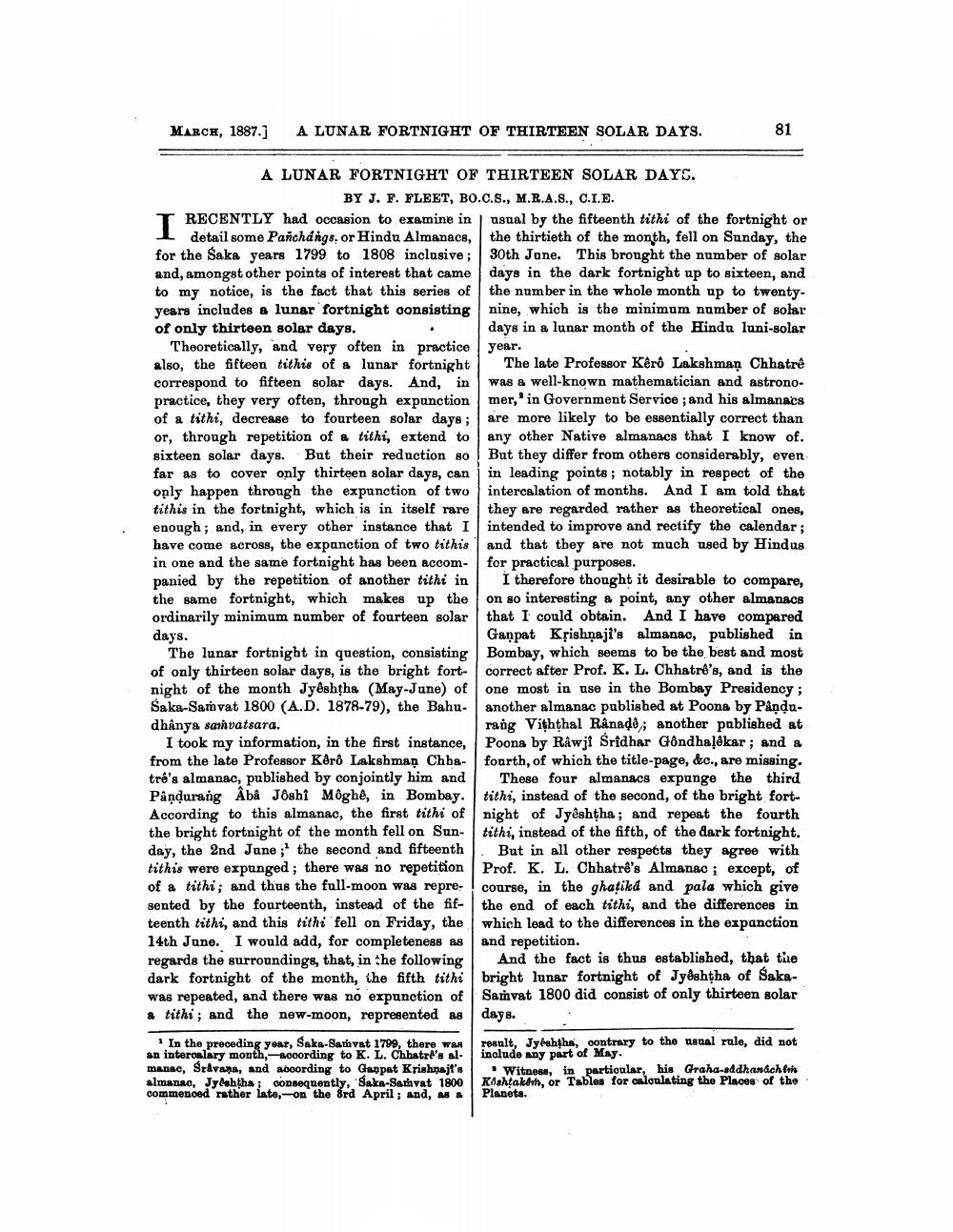________________
MARCH, 1887.] A LUNAR FORTNIGHT OF THIRTEEN SOLAR DAYS.
A LUNAR FORTNIGHT OF THIRTEEN SOLAR DAYS.
BY J. F. FLEET, BO.C.S., M.R.A.S., C.I.E. RECENTLY had occasion to examine in I detail some Panchangs, or Hindu Almanacs, for the Saka years 1799 to 1808 inclusive; and, amongst other points of interest that came to my notice, is the fact that this series of years includes a lunar fortnight consisting of only thirteen solar days.
Theoretically, and very often in practice also, the fifteen tithis of a lunar fortnight correspond to fifteen solar days. And, in practice, they very often, through expunction of a tithi, decrease to fourteen solar days; or, through repetition of a tithi, extend to sixteen solar days. But their reduction so far as to cover only thirteen solar days, can only happen through the expunction of two tithis in the fortnight, which is in itself rare enough; and, in every other instance that I have come across, the expunction of two tithis in one and the same fortnight has been accompanied by the repetition of another tithi in the same fortnight, which makes up the ordinarily minimum number of fourteen solar days.
The lunar fortnight in question, consisting of only thirteen solar days, is the bright fortnight of the month Jyêshtha (May-June) of Saka-Samvat 1800 (A.D. 1878-79), the Bahudhanya samvatsara.
I took my information, in the first instance, from the late Professor Kêrô Lakshman Chhatrê's almanac, published by conjointly him and Pandurang Aba Joshi Môghê, in Bombay. According to this almanac, the first tithi of the bright fortnight of the month fell on Sunday, the 2nd June;' the second and fifteenth tithis were expunged; there was no repetition of a tithi; and thus the full-moon was represented by the fourteenth, instead of the fifteenth tithi, and this tithi fell on Friday, the 14th June. I would add, for completeness as regards the surroundings, that, in the following dark fortnight of the month, the fifth tithi was repeated, and there was no expunction of a tithi; and the new-moon, represented as
In the preceding year, Saka-Samvat 1799, there was an intercalary month,-according to K. L. Chhatre's almanac, Sravana, and according to Ganpat Krishnajt's almanac, Jyeshtha; consequently, Saka-Samvat 1800 commenced rather late,-on the 3rd April; and, as a
81
usual by the fifteenth tithi of the fortnight or the thirtieth of the month, fell on Sunday, the 30th June. This brought the number of solar days in the dark fortnight up to sixteen, and the number in the whole month up to twentynine, which is the minimum number of solar days in a lunar month of the Hindu luni-solar year.
The late Professor Kêrô Lakshman Chhatrê was a well-known mathematician and astronomer, in Government Service; and his almanacs are more likely to be essentially correct than any other Native almanacs that I know of. But they differ from others considerably, even in leading points; notably in respect of the intercalation of months. And I am told that they are regarded rather as theoretical ones, intended to improve and rectify the calendar; and that they are not much used by Hindus for practical purposes.
I therefore thought it desirable to compare, on so interesting a point, any other almanacs that I could obtain. And I have compared Ganpat Krishnaji's almanac, published in Bombay, which seems to be the best and most correct after Prof. K. L. Chhatre's, and is the one most in use in the Bombay Presidency; another almanac published at Poona by Pândurang Viththal Rânado; another published at Poona by Rawji Sridhar Gôndhalêkar; and a fourth, of which the title-page, &c., are missing.
These four almanacs expunge the third tithi, instead of the second, of the bright fortnight of Jyeshtha; and repeat the fourth tithi, instead of the fifth, of the dark fortnight.
But in all other respects they agree with Prof. K. L. Chhatrê's Almanac; except, of course, in the ghatiká and pala which give the end of each tithi, and the differences in which lead to the differences in the expanction and repetition.
And the fact is thus established, that the bright lunar fortnight of Jyêshtha of SakaSamvat 1800 did consist of only thirteen solar days.
result, Jyeshtha, contrary to the usual rule, did not include any part of May.
3
Witness, in particular, his Graha-addhanachim Koshṭake, or Tables for calculating the Places of the Planets.




